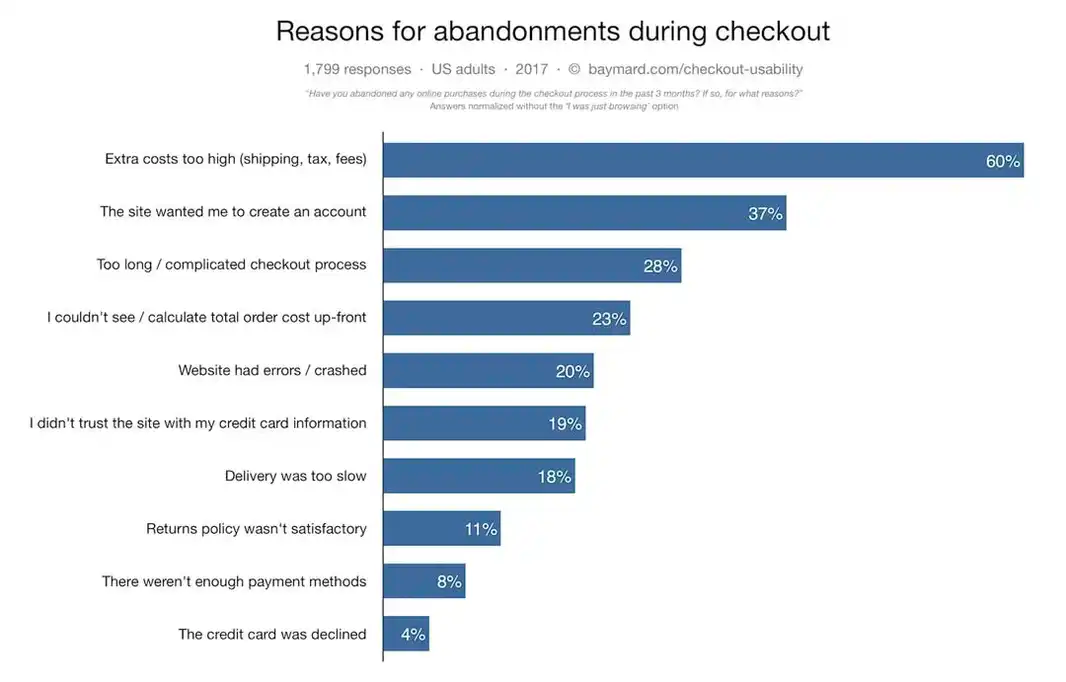Shopping cart abandonment is a problem that most ecommerce retailers have to deal with. It happens when a customer starts the checkout process for an order but doesn’t complete the purchase.
According to Statista, the average cart abandonment rate in 2017 was 69.23%, but this number rose to 88% in March 2020. Findings from several studies on shopping cart abandonment show that on average, three out of four online shopping carts are abandoned without a purchase.
Your shopping cart abandonment rate represents an opportunity lost and a gap in potential conversions. A 65% cart abandonment rate leaves a 97.9% gap in conversions, costing retailers $2 to $4 trillion per year.
While you can’t eliminate shopping cart abandonment effects, you can understand the common factors that influence it. And thanks to research, you can also learn how to reduce shopping cart abandonment effects.
Read guide or jump ahead to specific sections:
- The significant effects of shopping cart abandonment
- How to decrease shopping cart abandonment
- Final thoughts: how to reduce shopping cart abandonment effects
Shopping Cart Abandonment Effects
The shopping cart abandonment rate is a crucial ecommerce metric to track, as high cart abandonment rates indicate a poor user experience or flawed sales funnel.
When cart abandoners unintentionally (or intentionally) fail to convert (as TikTok activists did to the Trump online store), it contributes negatively to an online store’s inventory and data collection efforts.
When there are more items in an online shopping cart than inventory, the shop will assume that it’s available to sell, affecting inventory planning.
Additionally, shopping cart abandonment impacts data collection because ecommerce store owners cannot tell which of their customers were just messing with them, and which actually had a bad user experience.
Shopping cart abandonment effects also impact a company’s digital campaign spend because retailers will often reach out to potential buyers with a retargeting campaign.
How To Decrease Shopping Cart Abandonment
According to Baymard Institute, the most common reasons for cart abandonment include additional costs being too high, needing to create an account, and a convoluted checkout process.

Here are some proven ways to reduce shopping cart abandonment:
1. Consider Free Shipping
Baymard Institute’s research shows that 60% of carts are abandoned due to unexpected costs such as high shipping fees, which can be explained by a phenomenon called price anchoring.
If a customer sees the retail price at $14.99 and after taxes and fees, it rises to $19.99, the customer will get discouraged because they benchmarked against the first price.
Many studies have found that if customers have to choose, they prefer free (and cheaper) shipping over expedited shipping.
Growing ecommerce sales are driving up ecommerce logistics costs, which eats into profit margins, especially if you ship overseas. So if free shipping isn’t an option, offer discount vouchers and coupon codes instead.
Tips:
- Offer free shipping on standard delivery. Charge additional fees for expedited shipping.
- Charge shipping for low-value products and offer free shipping for high-value products.
- Offer free shipping for a minimum order value.
2. Simplify the Checkout Process
According to Baymard Institute’s survey, 28% of respondents abandoned their online carts because of a complicated checkout process. An additional 37% abandoned their ecommerce shopping carts because the website wanted them to make an account.
Tips:
- Decrease the number of steps required for checkout. Baymard Institute’s research shows that the average checkout flow for new users is 5.1 steps. Offer one-step checkouts, as ecommerce giant Amazon does.
- Offer guest checkouts, so users don’t have to create accounts.
- Autofill form fields, so shoppers don’t have to add in information manually.
- Be transparent about your return policy.
Ensuring a smooth checkout flow pays off — checkout optimization can increase conversions by 35.26%.
3. Increase Website Speed
A good user experience is vital to customers, and fast page load speed factors into that. A study by Akamai found that a two-second delay in load time increases bounce rates by 103%. Additionally, a 100-millisecond delay decreases conversion rates by 7%.
Tips:
- Reduce file size while retaining image quality with image compression.
- Install a content delivery network (CDN).
- Choose the best web hosting provider.
4. Optimize for Mobile Responsiveness
These days, more than 50% of consumers access the internet and shop on their mobile devices. In 2021, mobile ecommerce sales are expected to account for nearly 54% of all ecommerce sales.
Mobile ecommerce is lucrative, but without a mobile-optimized ecommerce website, the probability of shopping cart abandonment increases.
Barilliance did a study on cart abandonment rates according to device. While the average cart abandonment rate was around 75%, it shot up to 85.65% on mobile.
Tips:
- Create a stripped-down version of your ecommerce site.
- Do not bog users down with popups or sidebars.
- Ensure call to action (CTA) buttons are the appropriate size to avoid errors.
- Consider using an ecommerce website template with cart optimization built-in.
5. Offer Various Payment Options
By creating an online store, you’re essentially opening your store for global consumers. When it comes to payment, it’s not a one-size-fits-all situation.
For instance, some countries aren’t big on credit cards or mobile wallets, which are the preferred payment methods in Australia, Europe, and the U.S.

PayPal and Stripe are among the most popular payment providers, but even PayPal doesn’t support certain countries. If you plan to offer your products internationally, offer multiple payment methods.
Tips:
- Allow customers to pay with a guest account.
- Don’t ask for extra or unneeded information.
- Ensure website security and privacy – every consumer is counting on that from you.
6. Inspire Trust With a Secure Website
Ecommerce stores handle sensitive personal and financial information. Give your potential customers peace of mind by ensuring they can trust your website.
According to Baymard Institute’s study, one-fifth of online shoppers said they abandoned carts because they felt like they couldn’t trust the website.
Tips:
- Incorporate website security features, such as password encryption, two-factor authentication, and SSL certificates.
- Provide contact details, such as phone numbers or email addresses that customers can use to reach you.
- Inspire trust through testimonials, product reviews, and social proof.
7. Retarget Customers Using Abandoned Cart Emails
If the above tips don’t work, you can try retargeting through cart abandonment emails.
Abandoned cart recovery emails are sent to shoppers to remind them of the items they were interested in buying but did not purchase. Usually, these emails include offers such as discount codes and a personalized link to let the customer pick up where they left off.
Abandoned cart emails can be sent using email marketing platforms, although some ecommerce solutions such as WooCommerce or StoreBuilder may have them as built-in features.
Tips:
- Use other channels to complement your abandoned cart emails (for example, retargeting, push notifications, Messenger applications, and cold calls).
- Leverage automation and personalization.
- Use A/B testing.
Final Thoughts: How to Reduce Shopping Cart Abandonment Effects
Shopping cart abandonment is an important metric that online retailers should take into consideration as they plan for and manage their online stores. Because shopping cart abandonment directly correlates to sales and revenue, retailers must optimize the user experience and checkout process.
To address cart abandonment for our customers, Nexcess has partnered with Recapture, an application that assists in abandoned cart recovery. You’ll get access to Recapture and other features that support sales & conversions when you sign up for StoreBuilder or a Nexcess managed WooCommerce hosting plan.

